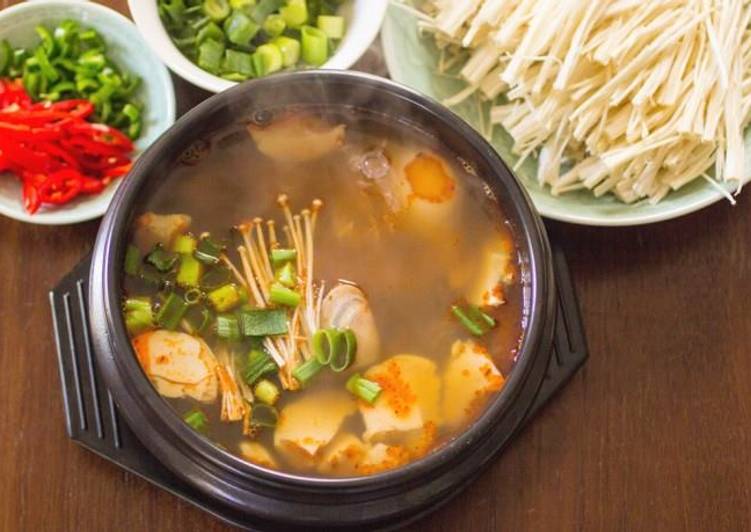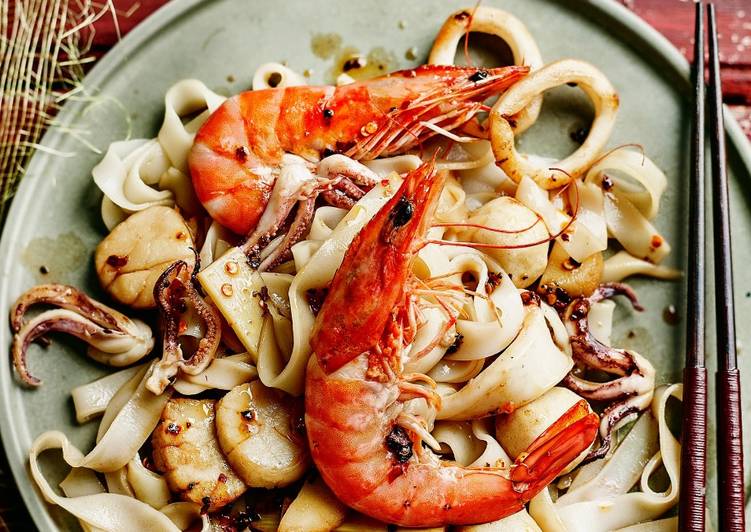
Hey everyone, hope you’re having an amazing day today. Today, I will show you a way to prepare a special dish, sundubu. One of my favorites. For mine, I am going to make it a little bit unique. This will be really delicious.
Sundubu is one of the most popular of current trending foods on earth. It is simple, it’s quick, it tastes delicious. It is appreciated by millions every day. Sundubu is something which I have loved my whole life. They are fine and they look wonderful.
What is Sundubu Jjigae (Korean spicy soft tofu stew, 해물 순두부 찌개)? Sundubu Jjigae is Korean stew made with soft (uncurdled) tofu. As you can imagine, the tofu texture is silky soft and because of that, this tofu is also a popular choice as a baby food.
To get started with this recipe, we have to first prepare a few ingredients. You can have sundubu using 20 ingredients and 10 steps. Here is how you cook it.
The ingredients needed to make Sundubu:
- Prepare 3 tubes of 220g soft tofu (cut into slices)
- Take 1/4 tsp salt (to season tofu)
- Take 1 green serrano chilli
- Take 1 red cayenne chilli
- Make ready 1 dozen oysters (remove shells)
- Get 1 L water and 1 tbsp salt (for rinsing oysters)
- Make ready 300 g pipi clams
- Take 1 L water and 1 tbsp salt (for soaking)
- Prepare 1 tbsp salt (for soaking)
- Take 4 tbsp vegetable stock (or 1 cube of vegetable stock)
- Make ready 1 bunch enoki mushrooms (roots removed and separated)
- Get 1 stalk spring onions (diagonally sliced)
- Make ready 1 egg
- Take soup seasoning:
- Make ready 1 tbsp Sempio Chosun Ganjang (Naturally Brewed Soy Sauce for Soup, Chosun)
- Prepare 1 tsp Korean Fish Sauce
- Take 1 tbsp Korean soy sauce
- Make ready 1 tbsp garlic (minced)
- Take 1 tbsp crushed Korean Red Pepper Powder
- Make ready 1 tbsp sesame Sauce
It's hot, spicy, filling, comforting, delicious, soft tofu stew and has many reasons to be one of the most popular items in Korean restaurants. I made a video and recipe for sundubu-jjigae seven years ago (!) and it's been watched over a million times on YouTube (!!). So it was about time for an HD remake and a. One of the most representative dishes of Korean cuisine is sundubu jjigae (순두부 찌개), halfway between a thick soup and a juicy tofu stew.
Steps to make Sundubu:
- Start boiling a 1 litre pot or clay pot of water.
- Combine the soup seasoning ingredients. Mix well and reserve.
- Sprinkle salt on the soft tofu and let it absorb the salt for about 10 minutes.
- Chop spring onions, red and green peppers. Set aside.
- Wash and rinse oysters using salted water (1L water and 1 tbsp salt). Drain and remove any excess moisture. Set aside.
- Let the pipi clams exude debris by soaking them in salted water (1L water and 1 tbsp salt). Set aside.
- Add vegetable broth and all ingredients with seasoning to a clay pot and heat till boiling.
- Add soft tofu, oysters and clams to the boiling clay pot. Continue boiling for 1 min so the flavours blend together making soft tofu soup.
- Garnish the boiling soup with mushrooms, Korean Red Peppers and green pepper and spring onions.
- Break the egg and add it to the boiling soup. Serve.
In Korean cuisine, a jjigae is a simmered or braised dish. In Korean, sundubu means 'tofu' but a variety of soft, fresh, undrained, unpressed tofu, commonly known as silky tofu or soft tofu. The rainy weather these days make me crave for Sundubu Jjigae 순두부찌개 or Korean Soft Tofu Stew so much. The popular Korean dish consist of soft tofu submerged in a deep-red spicy stew in a hot-piping bowl with ingredients such as seafood, sometimes meat, mushrooms, onions, and vegetables. The Korean stew (jjigae, 찌개) made with sundubu (or soondubu, 순두부) is enormously popular both in and outside Korea.
So that’s going to wrap it up with this exceptional food sundubu recipe. Thanks so much for your time. I’m sure that you can make this at home. There’s gonna be interesting food in home recipes coming up. Don’t forget to bookmark this page on your browser, and share it to your family, colleague and friends. Thank you for reading. Go on get cooking!


